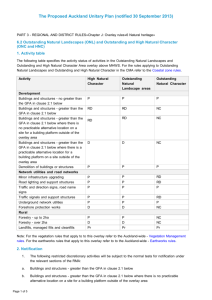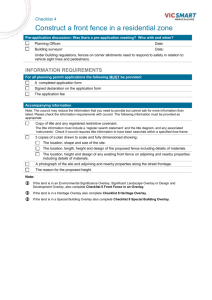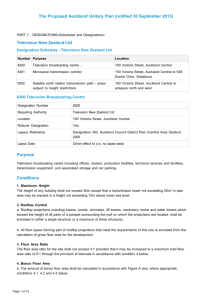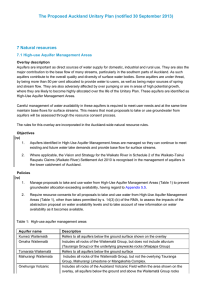The Proposed Auckland Unitary Plan
advertisement
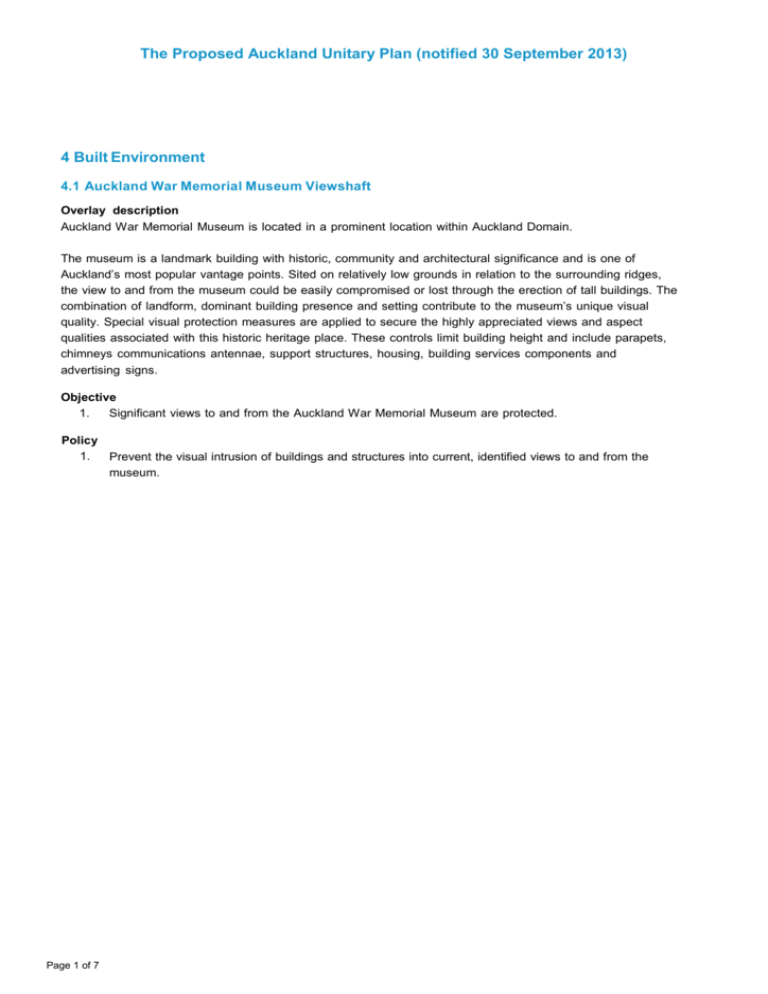
The Proposed Auckland Unitary Plan (notified 30 September 2013) 4 Built Environment 4.1 Auckland War Memorial Museum Viewshaft Overlay description Auckland War Memorial Museum is located in a prominent location within Auckland Domain. The museum is a landmark building with historic, community and architectural significance and is one of Auckland’s most popular vantage points. Sited on relatively low grounds in relation to the surrounding ridges, the view to and from the museum could be easily compromised or lost through the erection of tall buildings. The combination of landform, dominant building presence and setting contribute to the museum’s unique visual quality. Special visual protection measures are applied to secure the highly appreciated views and aspect qualities associated with this historic heritage place. These controls limit building height and include parapets, chimneys communications antennae, support structures, housing, building services components and advertising signs. Objective 1. Significant views to and from the Auckland War Memorial Museum are protected. Policy 1. Prevent the visual intrusion of buildings and structures into current, identified views to and from the museum. Page 1 of 7 The Proposed Auckland Unitary Plan (notified 30 September 2013) 4.2 Indicative Roads and Open Space Overlay description The location of indicative roads play an important part in creating connections for new communities in greenfieds areas. The ad hoc development of roads can result in poor outcomes in terms of access, design and how an area functions. Similarly for indicative open space, it is important that: • adequate open space is provided at the time of subdivision • there are connections between areas of open space within a subdivision • connections with the open space network beyond the immediate area. It is important that roads and open space networks function as intended through the subdivision process. Objective 1. A connected road and open space network is provided at the time of subdivision. Policy 1. Require sites to be served by a road and open space network which is integrated with the existing and proposed road and open space network at the time of subdivision. Page 2 of 7 The Proposed Auckland Unitary Plan (notified 30 September 2013) 4.3 Ridgeline Protection Overlay description Auckland contains a number of prominent ridgelines that geographically mark the edges of Auckland’s urban areas and provide an important visual backdrop. Appropriate placement and scale of buildings is important to ensure these qualities are protected and maintained. These include the ridgelines of Waitakere Ranges and the significant Scenic Drive scarp which are within the Waitakere Ranges Heritage Area and are therefore afforded a higher level of protection. Objective 1. The visual landscape qualities of Auckland’s ridgelines provide a visual backdrop to urban Auckland. Policy 1. Control the location and scale of buildings to ensure they do not protrude above or dominate the identified ridgelines when viewed from a public place. Page 3 of 7 The Proposed Auckland Unitary Plan (notified 30 September 2013) 4.4 City Centre Fringe Office Overlay description The City Centre Fringe Office overlay applies to areas of the Mixed Use zone and Local Centre zone in the fringe area around the city centre. The purpose of the overlay is to enable intensive office activities close to the city centre, where public transport services are excellent. This is achieved by removing the GFA limitation on office activities. Objective 1. Intensive office opportunities exist in commercial areas surrounding the city centre. Policy 1. Provide opportunities for substantial office activities in the Mixed Use zone and the Local Centre zone in areas surrounding the city centre, recognising their proximity to the city centre and availability of excellent public transport services. Page 4 of 7 The Proposed Auckland Unitary Plan (notified 30 September 2013) 4.5 Identified Growth Corridor Overlay description The overlay is applied to a limited number of significant road corridors or significant segments of these corridors. The purpose of the overlay is to provide additional opportunity to those commercial activities (predominantly retail activities) that: • may not be appropriate for, or are not able to locate in centres due to the size, scale or nature of the activity, and • are not typically provided for in the underlying zone. Where commercial activities are enabled by an identified growth corridor, these should: • respect the current land uses and the outcomes anticipated by the underlying zone • support a compact urban form • maintain the safety and efficiency of the road network and promote integrated transport • not diminish the function and viability of the city centre, metropolitan, town and local centres. The overlay only relates to those sites that have direct frontage to the identified growth corridor. The overlay is a policy overlay. It does not change the activity status of land use activities within the overlay area. It provides additional objectives and policies that must be considered when assessing a proposal for a resource consent. Objectives 1. A mix of compatible commercial activities that may not be appropriate for, or are not able to locate in centres, is provided for, that will not have a significant adverse effect on the vitality and viability of centres. 2. An improved amenity and street environment that integrates with the transport network. 3. A range of commercial activities that minimises adverse effects on existing development in the surrounding area. Policies 1. Apply the overlay only to those sites which have direct frontage to the identified growth corridor. 2. Page 5 of 7 Assess applications for commercial activities against the RPS - Commercial and Industrial Growth, Policy 7. The PrOilOsed Auckland Unitary Plan (notified 30 September 2013) Figure 1: ldentifie::l GroWh Corridor locctions ·lincoln Road ...... \• '.. •.... I .... ........... ...•• •• --........... '• ! ......... -· \ • FlCdt....IIJIJWic: -lf4,>lh:l; lf'O"o1_ )< The Proposed Auckland Unitary Plan (notified 30 September 2013) 4.6 Local Public Views Overlay description In addition to the distinctive volcanic landscape and regionally significant Outstanding Natural Landscapes and Outstanding Natural Features, Auckland’s wider landscape and maritime setting provides a sense of identity at the local level. Individual viewing points, and their significant viewshafts from public places, contribute to the unique character of many of our neighbourhoods and coastal areas. Although many significant local views are naturally self-preserved by topography or proximity to the coast and require no specific protective restrictions, some are in prominent public locations but could be obstructed by buildings occurring in the foreground. These viewing points and the views from them have been identified to ensure the benefits they provide are retained for future generations. Objectives 1. Views to locally significant viewshafts are protected. Policies 1. Identify significant local public viewshafts using the following criteria: a. the extent to which the public viewshaft contributes to the aesthetic value or visual legibility of the wider natural landscape b. the community association with, or public appreciation of, the values of the viewshaft c. the visual coherence, unity or integrity of the viewshaft and its view d. the potential value of the viewshaft for public education, including known historic associations in relation to the site where the viewshaft originates. 2. Manage development on sites within the viewshafts to avoid adverse physical and visual effects on the viewshaft including adverse cumulative effects on the viewshaft. 3. Require public access to be maintained to the viewing point where the viewshaft originates. Page 7 of 7


